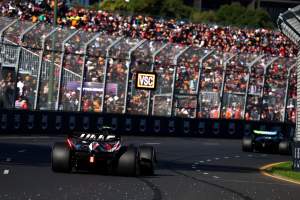Up Next

The timing of two of 2023 Australian Grand Prix’s red flags – the first very early in the race, the next almost at the end – determined its two very different aspects.
It will be remembered for the thrills and the spills, the late drama of a restart with just two laps to go, the way that put in jeopardy Max Verstappen’s victory.
But before Kevin Magnussen clipped the Turn 2 wall, leaving wheel rim and other assorted debris across the track, the race had settled down into a tyre-managing stalemate.
The reason for that was the first red flag – the one for Alex Albon crashing his Williams out of sixth place into the Turn 6 wall – came early enough to make it a bit of a stretch to get to the end without stopping again even on the hard tyres everyone inevitably switched to for the restart. So once Verstappen had DRS’d his way past Lewis Hamilton shortly after the lap nine restart and pulled himself out 10 seconds so as to protect against any safety car, he was just cruising.
The Red Bull was comfortably fast enough to do that. The intrigue became whether Fernando Alonso’s third place Aston Martin could get within DRS reach of Hamilton. But he couldn’t press too hard, because of the tyres.
Hamilton, fretting over his own tyres, was always able to respond just enough to keep that gap above a second, forcing Alonso to regroup and try again, and again. And that’s how the podium was going to be: a dominant Verstappen from a closely-matched Hamilton and Alonso.
The fact that almost everyone was managing their pace so carefully in between safety cars meant the gaps were not really opening up very quickly, so you were always going to lose way too many positions by stopping again. That was a self-enforcing mechanism, a tightening knot of strategic stalemate.
The thrill of this race was the anticipation of what was going to happen at each of the three standing starts – for they were the only opportunities for the Verstappen-dominated form book to be upended.
First start
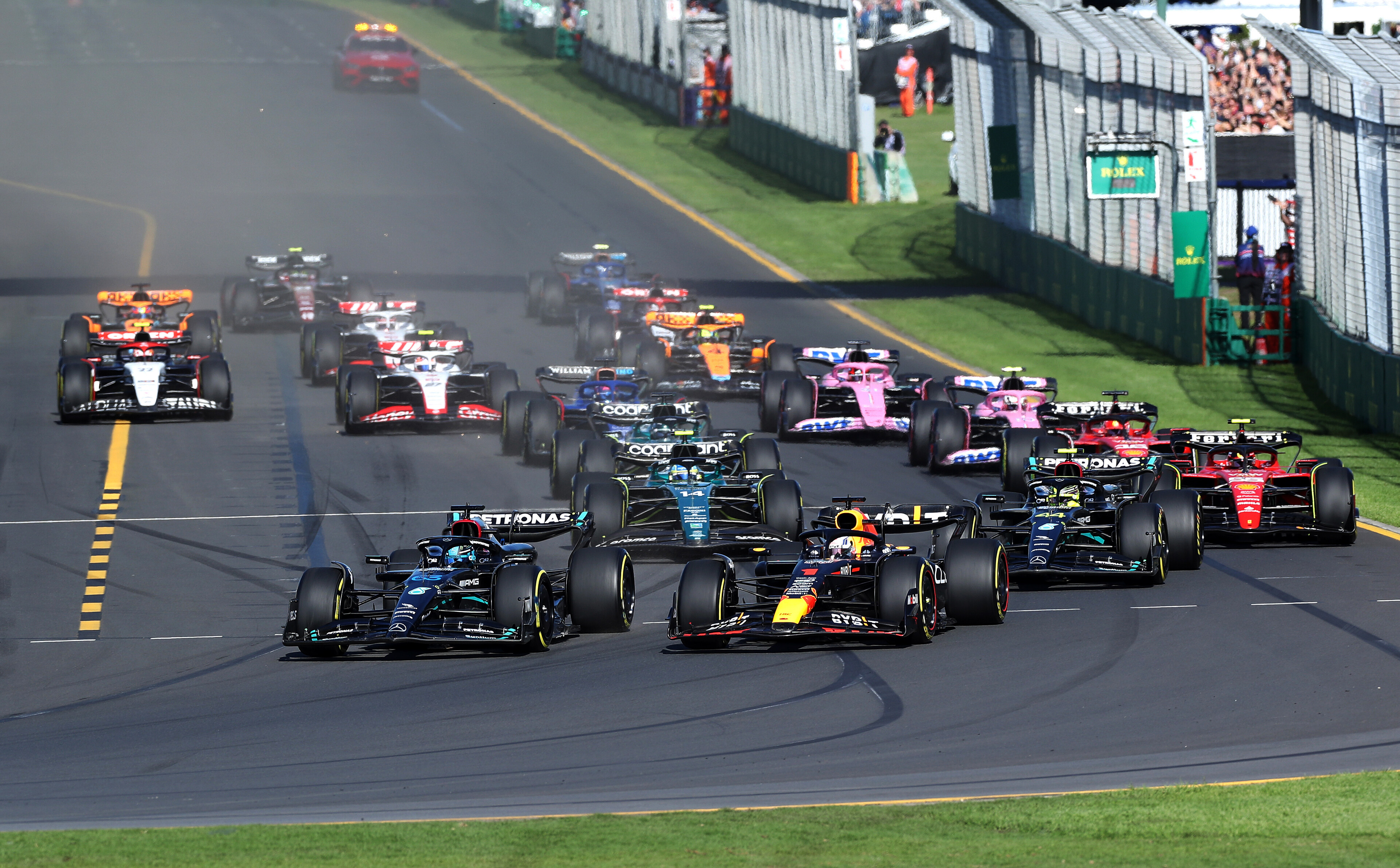
George Russell from alongside Verstappen on the front row got a flyer and simply launched himself down the Red Bull’s inside at Turn 1 to take the lead. Verstappen didn’t fight it out and in making room for Russell made himself vulnerable to the Hamilton-Alonso-Sainz-led pack behind.
This bunched that pack up as they ran down between the walls, through the kink and to the high-hazard braking area of Turn 3. Hamilton launched himself down the inside of the compromised Verstappen just as ruthlessly as Russell had done a few seconds earlier – and suddenly Mercedes had both cars ahead of Verstappen as the chaos began behind.
Lance Stroll found himself in a similar situation to lap one in Bahrain, with Alonso just ahead of him but another car – Charles Leclerc’s Ferrari – on his outside, trying to outbrake him. It came to the point where Leclerc had to turn in, but with Stroll having braked late to defend, they touched – and the Ferrari was spun into the gravel and out of the race. Stroll touched the back of Alonso again, but no harm was done to either Aston Martin, though it lost Alonso a place to Carlos Sainz. Hamilton was concerned the light contact he’d made with Verstappen may have damaged his wing, but it hadn’t.
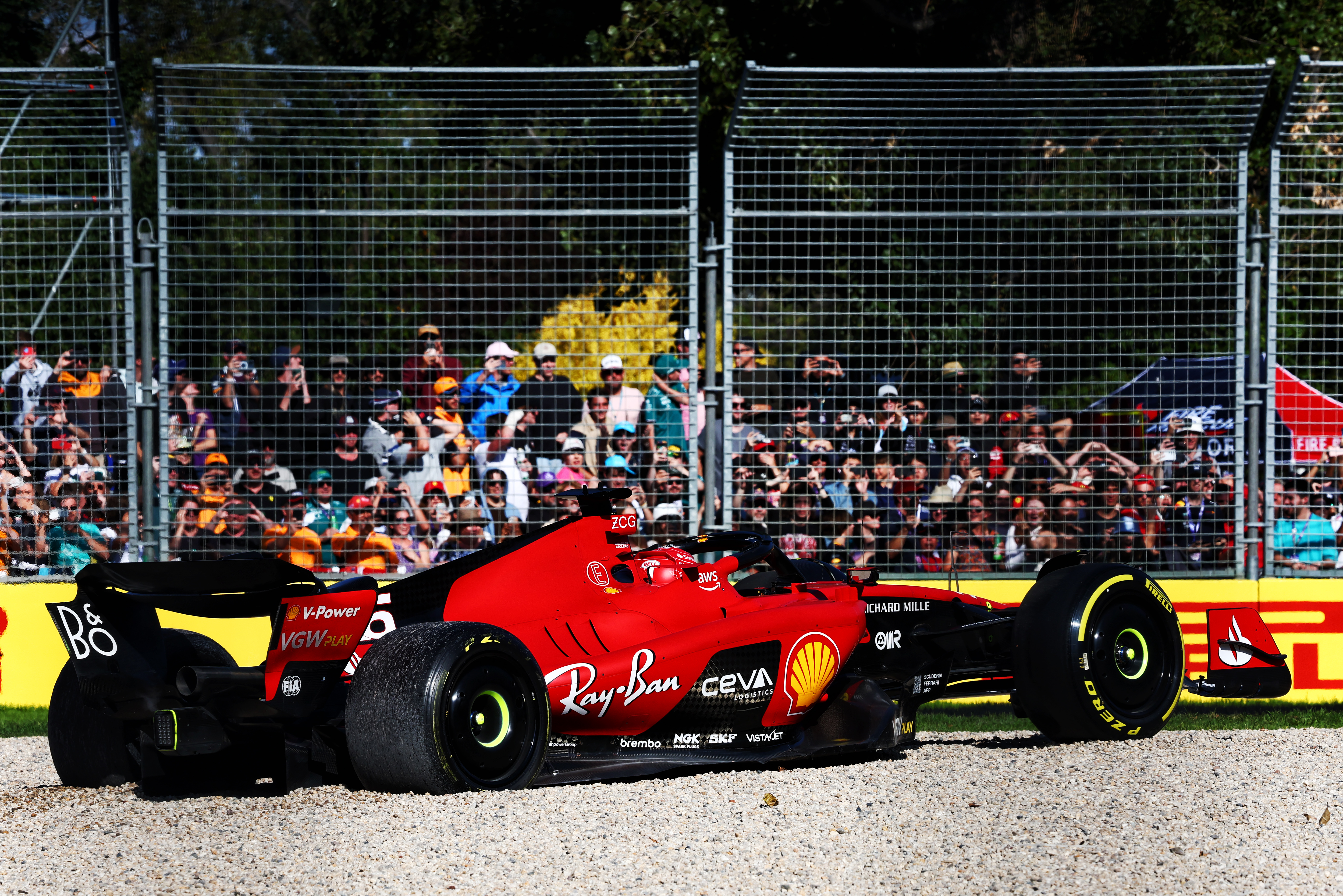
Safety car, rolling restart, Russell, Hamilton and Verstappen. Max had not been his usual no-compromise self on the opening lap, precisely because he knew he had no need to.
“I could have been a bit more aggressive,” he said. “I knew I had a quick car and knew losing a position at the start wasn’t end of the world.” Not only a quick car but a quick car in all the right places. Its advantage over Hamilton’s Mercedes – with both deploying DRS – was in the order of 9km/h and he was onto them.
Russell, having been told to manage his tyres carefully, was running slower than Hamilton needed him to if he was to keep Verstappen off his back and Hamilton was alongside him on the fourth lap, prompting Russell into complaints on the radio, Russell asking how he was supposed to be looking after his tyres while being attacked by his team-mate. Russell was released to up the pace, but still it seemed only a matter of time before Verstappen overcame both Mercedes.
But before that could happen, Albon was crashing his Williams. He felt he’d likely overheated the tyre when running on the Turn 5 astroturf which triggered the spin in Turn 6. Cue close shaves from those immediately behind amid the dust. Cue safety car.
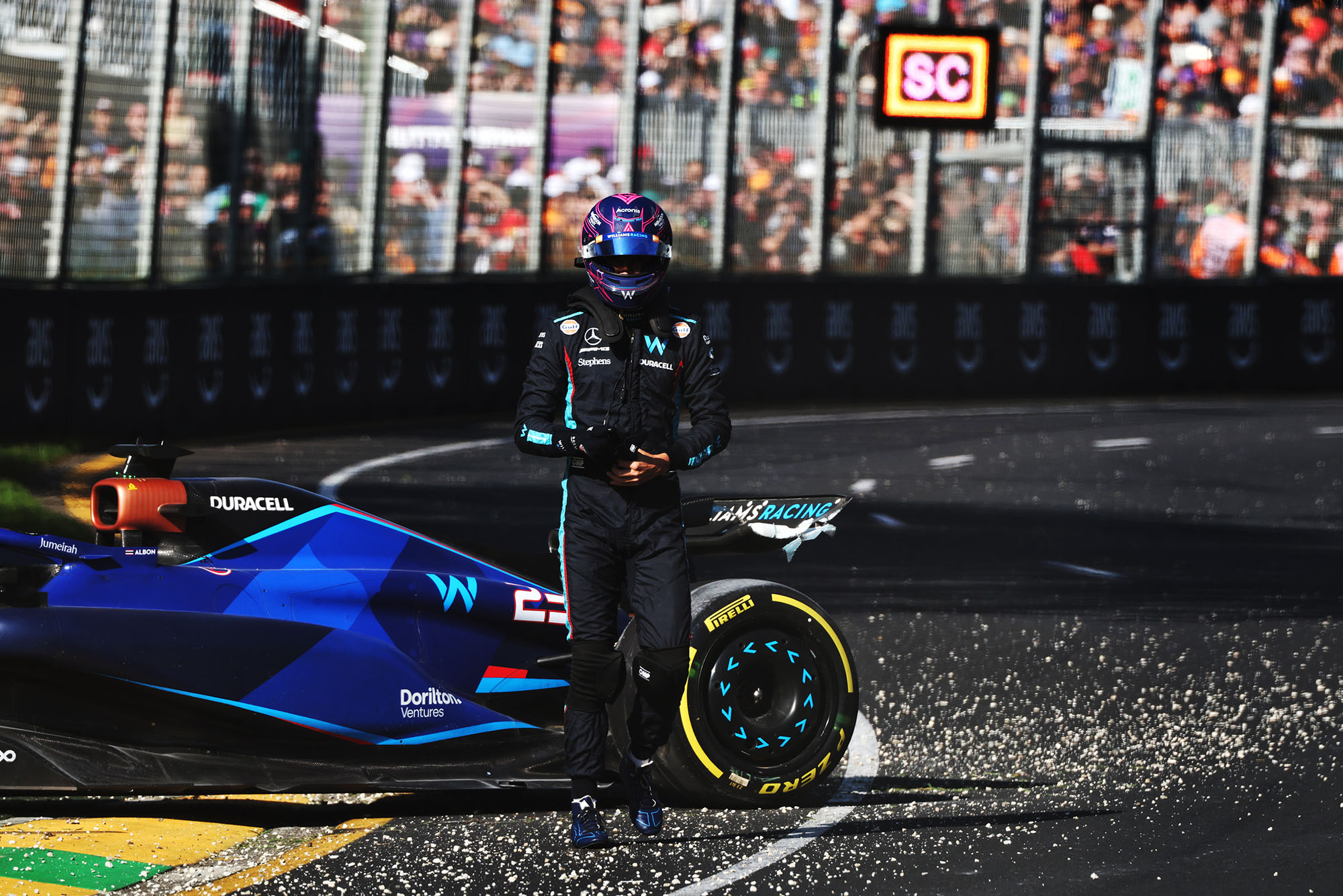
Cue also Mercedes pitting Russell from the lead and Ferrari doing the same with Sainz from fourth. With the 10s saving over a conventional stop, the safety car stop was too tempting for them to ignore. It gave Mercedes a foot in both strategic camps, but Russell as the leading driver was on the likely better strategy. “I saw Max and Lewis not pitting and was really surprised,” he said. “I came out on new tyres in P7 and they were just ahead I was thinking ‘the race is ours now’, I see no reason why we couldn’t won the race.”
Was he right? Doubtful. Verstappen’s pace advantage was such he’d likely have had enough pace to make up that 10s extra time loss.
Ferrari pulling Sainz in was good news for Alonso, putting him right on Verstappen’s tail in the safety car queue.
Then the red flag and free tyre changes – mediums off, hards on – for all those who’d not stopped, including Hamilton, Verstappen and Alonso. Too much gravel on the track. That switch in the race’s status had seriously damaged Russell’s race – even before he later retired with a suspected piston failure.
Second start

From the second standing start, Verstappen’s getaway was again poor, Hamilton unchallenged into the first turn. He stayed in the lead for only three laps, easy meat for Verstappen who went past on the long DRS run up to Turn 9, completing the move through the outside line of the entry to the fast left-right.
From there Verstappen pulled out 2s on Hamilton just in the remainder of the lap! Just like everyone else, Verstappen was intent on getting to the end, but there were still another 46 laps to go. His task was to open out a safety car margin on Hamilton, which he did within very few laps.
How come a Red Bull which tends to qualify only two or three tenths clear of the field has a much bigger margin than this in the race? Despite the more extensive use of the Red Bull’s huge DRS advantage in qualifying?
“We’ve weighted the car towards the race rather than qualifying,” answered Christian Horner. “So you can see there are cars which perhaps warm up their tyres a little more aggressively [in qualifying] and perhaps suffered more in the race.”
It’s perhaps a car which in how it limits the movement of its centre of pressure through its suspension geometry and underfloor design does not dive as much under braking and takes therefore a little longer to generate front tyre temperature? That’s maybe the only downside of the car’s concept – and if so even that only reduces (rather than eliminates) the margin of its superiority in qualifying.
Like that, Verstappen checked out.

Hamilton kept insisting he didn’t think his tyres were going to last the distance, given the pace that Alonso was imposing on him. The team knew otherwise. Alonso kept pushing, at one stage getting to within 1.2s. But never within DRS range, his tyres always demanding he cool them again, as Hamilton could always respond just enough.
“I think they [Aston Martin] were faster than us but we had position,” said Hamilton.
“I agree,” said Alonso. “If you can keep that close, it usually means you’d be faster if you were in front.” They were discussing making a second stop, but such was the close-packed field it would have lost them five positions and with relatively low tyre deg, not much of a tyre delta.
The Mercedes had qualified well because of its tyre usage, the way the team has found that it responds well to being run lower – and the smooth surface of this track allowing them to do that. This had given them that valuable track position. Which around a track on which you need Red Bull margins of superiority to overtake was all that it took to beat Alonso. But the W14 is still a more problematical car than the Aston Martin.
Sainz – who had dropped to 11th because of his pitting just before the red flag – came through aggressively, so that he was eventually running only a couple of seconds behind Alonso, but pulling along Pierre Gasly’s Alpine and Stroll’s Aston in his wake.
Sergio Perez, from his back of the grid slot, suffered no repeat of his apparent braking problem in qualifying, scythed through the pack and was just a couple of seconds behind Stroll with four laps to go, though it had taken him a time to pass the over-delivering Nico Hulkenberg (now ninth) and Lando Norris (eighth). Perez had set fastest lap of the race along the way. But everyone’s fastest laps were within the context of heavily managing the tyres.
Then Magnussen had that crash, just a shaving of the wall, but enough to pluck off the tyre, which damaged the rim. Safety car. Red flag.
Third start
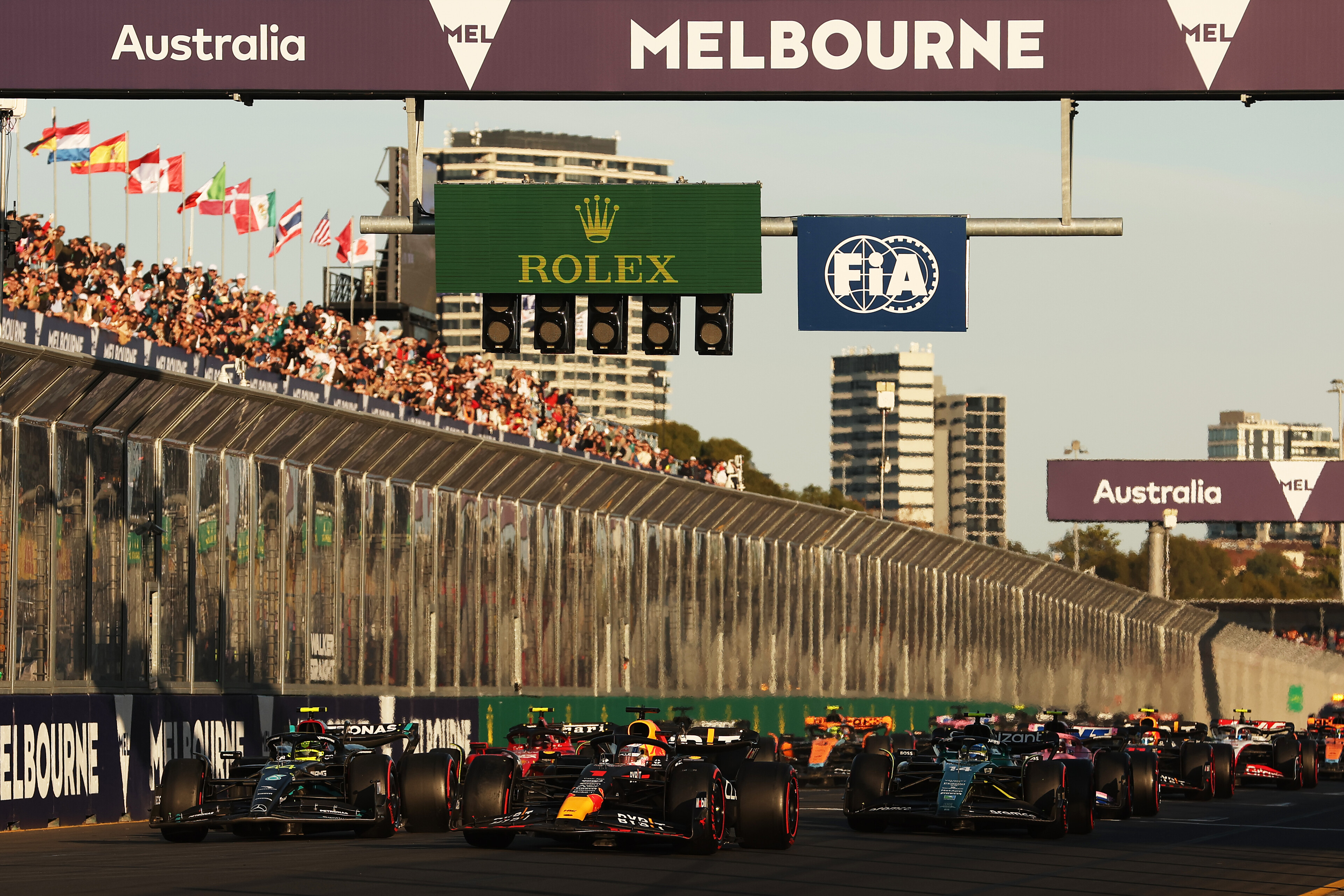
A two-lap sprint to the flag, with everyone on soft tyres, was a genuinely thrilling prospect. Verstappen finally got a decent start, Hamilton tucked in behind him. Sainz misjudged his braking slightly, hitting Alonso into a spin.
Gasly, who’d had a great race, was forced to lift and in a moment his team-mate Esteban Ocon was wedged between him and the wall, wrecking both Alpines.
Another red flag. Not enough laps left to have a race. Just enough to follow a safety car to confirm what the order was deemed to be at the timing loop at the SC2 line.
Alonso kept his podium. Sainz was penalised 5s for the Alonso incident and his fourth place became 12th.




